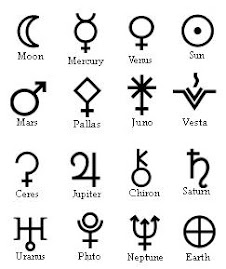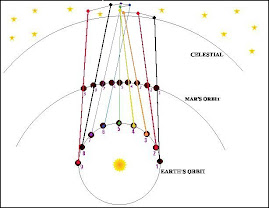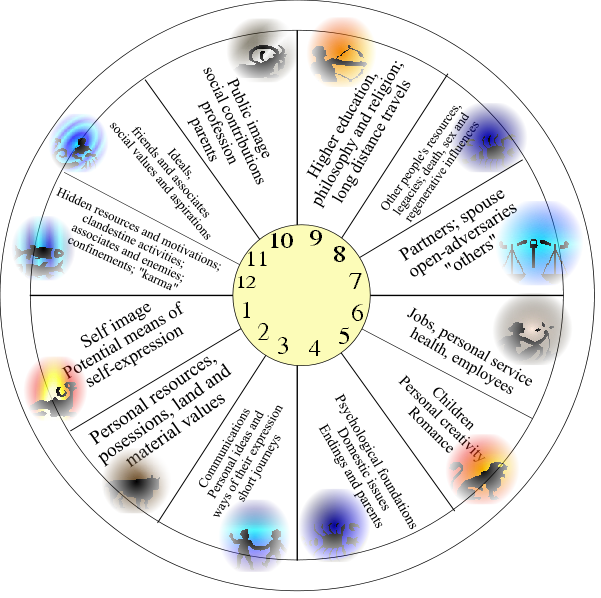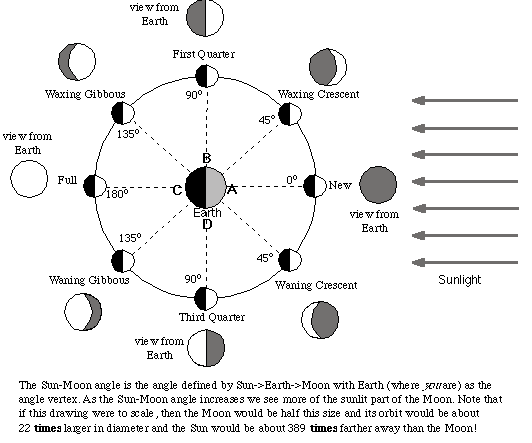A horoscope is a chart of the geocentric positions of the planetary bodies at the time of one's birth. The word "horoscope" is derived from the Greek words hora meaning "the hour", and skopos meaning "watcher". It refers to the act of watching for the arrival of a particular moment of time. The ancient practice of watching the position of the zodiac sign rising at the horizon in the sky at the moment of one's birth is based on the tenet that the individual's personality will assume the characteristics of the moment of his genesis.
When astrologers watched the exact degree of the zodiac sign rising at the horizon, they were in fact observing for the Rising Sign. As there are twelve zodiac signs in the sky, the Rising Sign at the horizon changes two-hourly. The Rising Sign has been labelled as "watcher of the hour" in the past. In fact, the earliest meaning of the horoscope was equated with that of the Rising Sign. Today, modern astrology has expanded the defintion of the horoscope to encompass all the planetary information in the birth chart.
In its graphic form, the horoscope is a cartwheel map of the heavens that charts the positions of the Sun, Moon, and planets as they appear at the time of the individual's birth, in relation to a given place on earth. Analyzing the planetary positions and their relationships to each other in the birth chart enables the astrologer to get a glimpse into his natural characer and life potentials.
The earliest form of astrological practice pertains to the characterisation of historical cycles and the fate of nations. Particular attention was paid to famines, natural disasters and wars. In ancient times, astrology was largely a system of celestial omens by which the fate of kingdoms and their rulers could be judged. Modern astrology has since developed the personal horoscope into a study of the individual's character and his relationship with time and the cycles of nature. This discipline has now become an art of understanding how a peron's life path fits into such cycles. In the same way as we use the hour and the minute hands of the clock to correlate with the passing of time, the horoscope can be perceived as a cosmic clock that correlates with the unfolding of our individual life cycles.
Whenever we say an astrologer "casts" a horoscope, we mean that he "freezes" all the positions of the moving planets in the sky at the moment of choice and converts that snapshot into a graphic representation of the heavens. This graphic representation is known as the birth chart. It maps our inner psyche.
The horoscope also charts our life intentions. It starts with the birth chart and thereafter flows with the natural planetary cycles. It shows what we intend to experience and choose to do at different times of our lives. It describes what our potentials are and what shape we give to our individuality as we grow. It guides us to connect with that part of ourselves which we know we will eventually become.
In astrology, the Sun and Moon are regarded as "planets". There are thus ten planets in the horoscope. The "clock" of the horoscope indicates teh timing of the ten planetary cycles. these cycles overlap and start ticking the moment a person is born.
The Sun's yearly cycle indicates a person's will, his being and short term goals. The Moon's monthly cycle depicts his emotional tide. Mercury and Venus cycles are roughly a year long each. Mercury describes his mental disposition and communication patterns whereas Venus paints a picture of his relationship and values. Mars has a two-year cycle that characterizes his drive and medium-term goals. The Jupiter cycle is 12-yearly in duration. It reveals his reward and recognition patterns. The Saturn cycle is even longer, about 29 years. It helps the individual to understand his maturity, responsibilities and challenges in life.
The cycles of the three outer planets are very much longer. A Uranus cycle is 84 years, a Neptune cycle 164 years and a Pluto cycle is 248 years. These three cycles work together in the horoscope and require the individual to let go, to accept and to redefine his life. Each of the three outer planets does that in a different way. Uranus redefines one's life by recognising his individuality, uniqueness and freedom. Neptune however perceives the individuation process as more than just a series of realizations about oneself. It redefines one's life by re-seeing the world through questioning the meaning of life. So, the Neptune cycle is about reality and illusion, aspiration and disappointment. However, a person's spiritual crisis is more than just an issue of the meaning of life. Pluto helps the individual to ask the question: "how much of this is really up to me?". Hence, Pluto in the horoscope symbolizes the individual's struggle with the forces of fate.
Wednesday, March 11, 2009
Friday, March 6, 2009
The Solar System in Astrology
Introduction
While astronomy deals primarily with the physical positions, dimensions, composition and motion of celestial bodies, astrology searches for the meaning in them by looking at them through the lens of symbolism. The existence of the Sun, Moon and the first five planets of the Solar System (i.e. Mercury, Mars, Venus, Jupiter, Saturn) is known to ancient man before the invention of the telescope. To the astrologer each planet represents more than just a celestial body. Rather it has a core symbolism which carries multiple layers of meanings derived from the core principle.
The Luminaries - Sun, Moon
Since ancient times, the Sun has been viewed with awe. Its shining light provides the life force and vitality necessary for growth and activity of all living things. When it sets, the mystical Moon takes over and shows the reflected light from the Sun. Together, these two bodies are known as the Luminaries.
The Sun and the Moon are polar opposites in astrology. They represent the psychological male-female principle in us. They are also associated with the harmonious balance of emotions in our psychological environment. This is classically known as the Yin-Yang principle in Chinese metaphysics. Their relationship to each other varies constantly with the Lunar Cycle and is important in shaping our core personalities.
The Personal Planets - Mercury, Venus, Mars
The first three planets of the Solar System (i.e. Mercury, Venus, Mars) are known as the personal planets in astrology. This is partly because their symbolism pertain to fundamental human urges. The first planet, Mercury, represents our urge to make connections. It carries the name of a Roman god who is the equivalent of the Greek Hermes. In fact the Greeks regard both the planets and their respective gods as psychological entities. Hermes is a multi-talented deity who is witty, clever with language and his hands and with travel. He moves freely between the living and the underworld and is known for his role as a messenger. Hence Mercury has come to symbolize mental activity, intelligence, communication and craftsmanship.
The second planet, Venus symbolizes the urge to make relationships. It is associated with two Greek goddesses, Aphrodite and Athena. Aphrodite is a symbol of beauty, love, sensuality and luxury. Athena on the other hand, is associated with peace, harmony, balance, wisdom and appreciation of artistic values. In the birth chart, the position of the planet Venus tells us about the individual's romantic inclinations and artistic talents.
Mars is a warrior god. The Romans honoured his spirit of courage, strength, sportsmanship and military discipline. In the natal chart it represents the nature of one's driving force, fighting spirit, assertion and anger. It tells us how easy or how difficult one shows up his anger and his manner of managing conflict.
The Social Planets - Jupiter, Saturn
Jupiter and Saturn ar known as the social or interpersonal planets because they are perceived to link us with our larger society and concepts beyond our individual confines. Being the largest planet of the Solar System, Jupiter's symbolism has been passed down as abundance, excess, optimism and good luck. In the birth chat, it tells us the urge of the individual to broaden his horizons and how he develops his philosophical and religious beliefs. If well placed in the chart, it can represent a positive outlook in life and an ability to take advantage of opportunities.
Saturn, by virtue of the fact that it is the outermost planet visible to the naked eye, has come to be associated with boundaries, limitations, restriction and death. The Saturn archetype is traditionally considered as negative, undesirable or evil. Its position in the natal chart often denotes the principle of fear and a perception o9f where one may fail in his life.
The Outer Planets - Uranus, Neptune, Pluto
Discovered only after the invention of the telescope in the 16th century, the outer planets (i.e. Uranus, Neptune and Pluto) have come to be associated with Modern Astrology. They are also known as the transpersonal or generational planets. Because of their wide orbits they take many years to move through each of the zodiac signs. Uranus stays for about 7 years in a sign, Neptune 14 years and Pluto about 20 years. Hence, in a natal chart, the sign the outer planets occupy is more descriptive of generational rather than personal issues. On the other hand, the houses they occupy would ground them on more personal issues.
At a personal level, Uranus indicates the impulsiveness, detachment and the area of life in which the individual may be eccentric. Neptune is involved with the individual's urge for sacrifice and redemption. Pluto, on the other hand is indicative of hidden power, change and transformation. These three planets have a strong role in the symbolism surroudning one's midlife crisis.
While astronomy deals primarily with the physical positions, dimensions, composition and motion of celestial bodies, astrology searches for the meaning in them by looking at them through the lens of symbolism. The existence of the Sun, Moon and the first five planets of the Solar System (i.e. Mercury, Mars, Venus, Jupiter, Saturn) is known to ancient man before the invention of the telescope. To the astrologer each planet represents more than just a celestial body. Rather it has a core symbolism which carries multiple layers of meanings derived from the core principle.
The Luminaries - Sun, Moon
Since ancient times, the Sun has been viewed with awe. Its shining light provides the life force and vitality necessary for growth and activity of all living things. When it sets, the mystical Moon takes over and shows the reflected light from the Sun. Together, these two bodies are known as the Luminaries.
The Sun and the Moon are polar opposites in astrology. They represent the psychological male-female principle in us. They are also associated with the harmonious balance of emotions in our psychological environment. This is classically known as the Yin-Yang principle in Chinese metaphysics. Their relationship to each other varies constantly with the Lunar Cycle and is important in shaping our core personalities.
The Personal Planets - Mercury, Venus, Mars
The first three planets of the Solar System (i.e. Mercury, Venus, Mars) are known as the personal planets in astrology. This is partly because their symbolism pertain to fundamental human urges. The first planet, Mercury, represents our urge to make connections. It carries the name of a Roman god who is the equivalent of the Greek Hermes. In fact the Greeks regard both the planets and their respective gods as psychological entities. Hermes is a multi-talented deity who is witty, clever with language and his hands and with travel. He moves freely between the living and the underworld and is known for his role as a messenger. Hence Mercury has come to symbolize mental activity, intelligence, communication and craftsmanship.
The second planet, Venus symbolizes the urge to make relationships. It is associated with two Greek goddesses, Aphrodite and Athena. Aphrodite is a symbol of beauty, love, sensuality and luxury. Athena on the other hand, is associated with peace, harmony, balance, wisdom and appreciation of artistic values. In the birth chart, the position of the planet Venus tells us about the individual's romantic inclinations and artistic talents.
Mars is a warrior god. The Romans honoured his spirit of courage, strength, sportsmanship and military discipline. In the natal chart it represents the nature of one's driving force, fighting spirit, assertion and anger. It tells us how easy or how difficult one shows up his anger and his manner of managing conflict.
The Social Planets - Jupiter, Saturn
Jupiter and Saturn ar known as the social or interpersonal planets because they are perceived to link us with our larger society and concepts beyond our individual confines. Being the largest planet of the Solar System, Jupiter's symbolism has been passed down as abundance, excess, optimism and good luck. In the birth chat, it tells us the urge of the individual to broaden his horizons and how he develops his philosophical and religious beliefs. If well placed in the chart, it can represent a positive outlook in life and an ability to take advantage of opportunities.
Saturn, by virtue of the fact that it is the outermost planet visible to the naked eye, has come to be associated with boundaries, limitations, restriction and death. The Saturn archetype is traditionally considered as negative, undesirable or evil. Its position in the natal chart often denotes the principle of fear and a perception o9f where one may fail in his life.
The Outer Planets - Uranus, Neptune, Pluto
Discovered only after the invention of the telescope in the 16th century, the outer planets (i.e. Uranus, Neptune and Pluto) have come to be associated with Modern Astrology. They are also known as the transpersonal or generational planets. Because of their wide orbits they take many years to move through each of the zodiac signs. Uranus stays for about 7 years in a sign, Neptune 14 years and Pluto about 20 years. Hence, in a natal chart, the sign the outer planets occupy is more descriptive of generational rather than personal issues. On the other hand, the houses they occupy would ground them on more personal issues.
At a personal level, Uranus indicates the impulsiveness, detachment and the area of life in which the individual may be eccentric. Neptune is involved with the individual's urge for sacrifice and redemption. Pluto, on the other hand is indicative of hidden power, change and transformation. These three planets have a strong role in the symbolism surroudning one's midlife crisis.
Subscribe to:
Posts (Atom)














